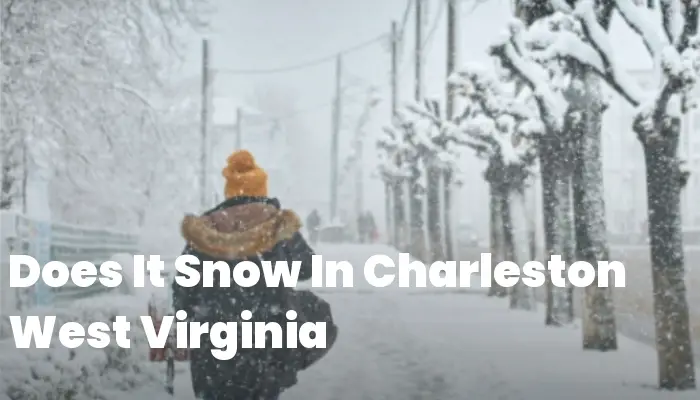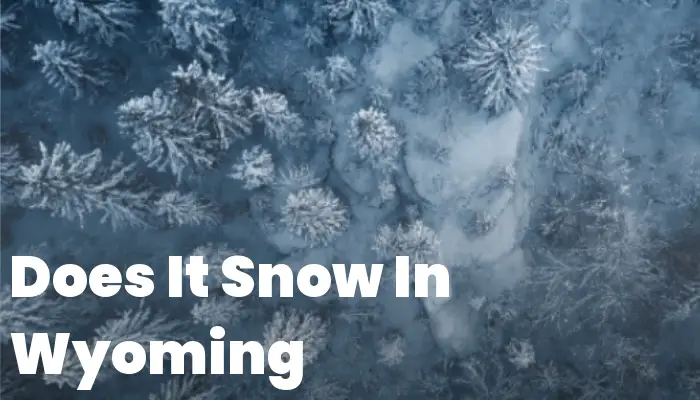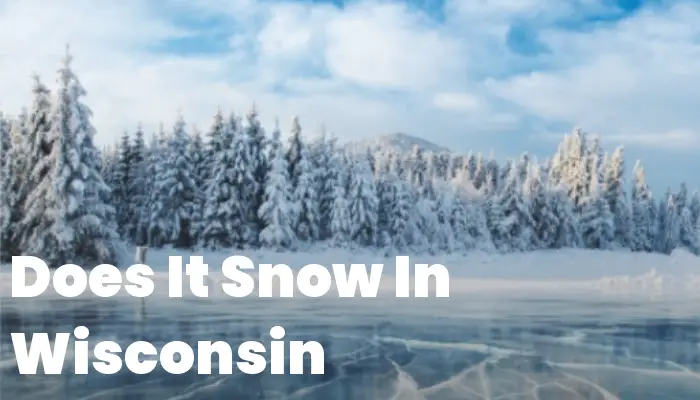Ever wondered about the climatic patterns in different parts of the world? One such intriguing question might be: Does It Snow In Charleston, West Virginia?
In this article, we delve deep into weather reports, historical climate data, and firsthand testimonies to unravel the truth behind this question. Whether you’re planning a winter vacation or considering a move, stay tuned to discover what to expect from Charleston’s winter season.
Does It Snow In Charleston, West Virginia?
Indeed, it does snow in Charleston, West Virginia. As the state capital and its largest city, Charleston experiences a humid subtropical climate that brings four distinct seasons. While winters can be quite chilly, they provide a picturesque blanket of snow regularly. The cold season generally runs from December to February and sees an influx of cold air masses that can sometimes bring significant snowfall to the region.
It’s not just about the charming snowy landscapes; residents know all too well that this weather also means being prepared for possible travel disruptions and taking safety precautions during winter months. Whether you’re a local or a visitor planning to experience the winter wonderland vibes of this historic city, knowing what to expect from Mother Nature is key.
How Much Does It Snow In Charleston, West Virginia?
When it comes to quantifying snowfall in Charleston, we look at average annual snowfall. Typically, Charleston receives about 32-40 inches of snow each year. However, this number can vary widely from year to year based on broader climatic patterns such as El Niño or La Niña events.
The heavy-hitters when it comes to winter weather usually hit in January and February. During these peak winter months, accumulation rates can sometimes exceed expectations overnight, turning the city into a serene snowy escape. That being said, there are also years where milder temperatures prevail leading to less than average inches on the ground.
What’s important for those who need to navigate through daily life during these snowy days is staying informed about snow forecasts and advisories. Whether it’s for commuting purposes or enjoying winter activities like sledding or skiing nearby, understanding how much snowfall is typical allows for better preparation and planning.
Are There Ice Storms In Charleston West Virginia?
While snowstorms are common, residents also brace themselves for another type of wintry challenge: ice storms. These events occur when a layer of freezing rain creates a coat of ice over surfaces—an occurrence that isn’t uncommon throughout winters in Charleston.
Ice storms have been known to cause significant issues including power outages due to downed lines under the weight of ice buildup as well as treacherous driving conditions leading to road accidents. Residents may recall notable past events that left large portions of the area without power and made simple tasks like walking outside hazardous due to slippery conditions.
Preparedness for such events involves not only physical readiness with things like generators and salt but also staying updated with local news outlets which provide crucial information on impending weather conditions. The severity and frequency make ice storms an integral aspect of understanding winter weather patterns within this mountainous region—highlighting why both locals and visitors should exercise caution while engaging in seasonal activities during colder months in Charleston.
In conclusion, if you’re looking forward to enjoying some wintry scenes or simply wondering how often you’ll need your shovel during your stay in Charleston—you now have a clearer idea of what typical winters look like here regarding snowfalls and icy encounters.
Those curious about the winter weather in Charleston, West Virginia, can find useful information in the article titled “Does It Snow In West Virginia”. Charleston experiences snowfall during winter months, reflecting the state’s climatic tendencies.
The article provides insights into seasonal patterns and snow accumulation, which can help residents and visitors of Charleston prepare for the cold season. Understanding when and how much it snows is essential for safe travel plans and enjoying winter activities in West Virginia’s capital.
The state of affairs regarding wintry precipitation, as described in the article, indicates that those living in or traveling to Charleston should anticipate seasonal snow and prepare accordingly. Whether it’s dressing warmly or planning for potential travel delays, knowledge about Charleston’s snowy season is key.
Where Does It Snow In Charleston, West Virginia?
Snowfall in Charleston is not uniformly distributed across the city. Certain areas are more prone to heavier snow than others, and this can often be attributed to elevation and topography. For instance, neighborhoods situated at higher elevations or in closer proximity to the surrounding Appalachian Mountains may see more snow due to orographic lift—an atmospheric process where moist air rises up a mountain and cools, leading to precipitation.
Areas such as South Hills and Fort Hill tend to receive greater amounts of snow compared to downtown Charleston thanks to their elevated positions. Conversely, lower-lying areas by the Kanawha River might experience slightly less accumulation due to warmer air currents. Monitoring local weather stations can provide a better indication of how these microclimates will affect overall snowfall distribution within the city limits.
Bulldog Field, Coonskin Park, and other recreational venues that offer winter sports may also experience different levels of natural snow, impacting how much artificial supplementing they need for activities like skiing or tubing. Understanding these subtle differences in local geography is essential for residents looking forward to enjoying winter sports or those responsible for clearing roads and sidewalks.
Charleston West Virginia Roads and Winter Weather Conditions
The road conditions in Charleston during winter are a crucial aspect for daily commuters as well as emergency services. The West Virginia Department of Transportation (WVDOT) works diligently through the snowy months ensuring major highways like I-64, I-77, and I-79 remain clear and safe for travel.
However, despite their efforts, winter storms can swiftly change driving conditions. Accumulating snow leads to slippery surfaces while visibility might be severely reduced during heavy snowfall—factors that contribute to hazardous travel conditions throughout the region. Secondary roads and rural routes are especially vulnerable after winter storms as they may take longer for plows and salt trucks to reach them.
Residents are advised always to check Road Condition Alerts from WVDOT before traveling during wintry weather situations. Adequate vehicle preparation—such as tire chains or using all-wheel drives—alongside carrying emergency kits with blankets, food, water is also stressed by local authorities as part of necessary precautions when venturing out into snowy conditions.
How Cold Does It Get In Charleston West Virginia?
When discussing chilly weather in Charleston, temperatures certainly deserve mention alongside discussions of ice and snow. Winter months frequently usher in brisk days with temperatures averaging between 20°F (-6°C) at night up through 40°F (4°C) during daytime peaks—but extremes can occur.
The coldest temperature ever recorded in Charleston was -19°F (-28°C), showcasing just how biting Appalachian winters can get. These frigid temperatures usually coincide with polar vortex events when arctic air dips down into eastern North America bringing unusually cold weather far southward into states like West Virginia.
Alongside being prepared for snowy landscapes or icy streets; proper attire such as heavy coats insulation layers waterproof boots hats gloves becomes critical when venturing outdoors amidst these freezing temperatures. Heating costs often spike during this time too; hence many households rely on various forms such as electricity gas firewood ensure homes stay warm cozy throughout season—reflecting another aspect life adapting typical cold spells faced each year Charleson residents.
When it comes to weather in West Virginia, many wonder, “Does It Snow In Charleston West Virginia?” The answer is, yes. Charleston, the capital city of the Mountain State, does get its fair share of snowfall during the winter months.
Meanwhile, if we move westward and ask “Does It Snow In Huntington West Virginia?” The answer is comparable as Huntington also experiences regular winter snowfall.
Shifting northwards to Parkersburg – “Does It Snow In Parkersburg West Virginia“? Yes, Parkersburg witnesses a significant amount of snow as well.
Located near the Pennsylvania border, if one asks “Does It Snow In Morgantown West Virginia“, the answer is again affirmative. Morgantown’s northern location means it often gets more snow than its southern counterparts.
Lastly, “Does It Snow In Wheeling West Virginia“? Like other regions in northern WV, Wheeling too experiences ample snowfall during winters.
Winter Activities In Charleston, West Virginia
As the snow blankets the city, winter activities in Charleston come to the forefront, offering fun and entertainment for everyone. One of the most popular attractions is Winterplace Ski Resort, located just a drive away from Charleston. Here, snow enthusiasts can indulge in skiing, snowboarding, and tubing. Closer to home, ice skating at Schoenbaum Ice Arena becomes a favorite pastime for families and individuals seeking leisurely recreation or robust exercise.
For those who enjoy a more serene winter experience, the snowy landscapes are perfect for photography or taking peaceful walks in parks like Kanawha State Forest. Nature doesn’t hibernate completely; bird watchers and wildlife spotters will find plenty of beauty to observe even during the colder months.
Local events also adapt to embrace the season. The annual Charleston Winter Blues Festival, for example, offers live music that warms the soul against chilly evenings. And don’t forget about holiday markets and festive decorations which transform Charleston into a winter wonderland throughout December—bringing joy and community spirit despite the cold weather outside.
Winter Traveling In Charleston West Virginia
Traveling during winter in Charleston can be challenging due to unpredictable weather conditions; however, with proper planning and vigilance, it remains possible. The key to winter traveling in Charleston is staying informed about current road conditions through resources like WVDOT’s live traffic alerts or local news updates.
Public transportation within Charleston remains operational as well—with buses servicing various routes around town including areas impacted by snowfall—though services may run on delayed schedules when heavy snow hits. For air travel, Yeager Airport is well-equipped with de-icing capabilities and maintains operation through most winter weather conditions though it’s always wise to check flight statuses ahead of time.
Perhaps one of enduring images of winter travel around here are lines trucks loaded with salt sand ready deploy at first sign storm—an iconic visual testament city’s readiness face off against Old Man Winter year after year ensuring roads stay passable residents visitors alike.
Snow Removal And City Preparations In Charleston West Virginia
Snow removal operations are critical in maintaining safe commutes and daily functions in urban settings like Charleston during heavy snowfall events. The City utilizes a fleet of plows salt spreaders equipped handle diverse challenges posed by Appalachian winters—from hills narrow streets crowded neighborhoods vast expanses highways all requiring attention clear ice accumulation promptly efficiently as possible.
City officials often implement strategic plans that prioritize main thoroughfares emergency routes followed by residential areas ensuring that essential services such as police ambulances fire departments maintain accessibility throughout severe weather periods Additionally there’s concerted effort keep walkways public spaces clear mitigating risks falls injuries pedestrians going about their day-to-day activities amidst wintery conditions.
In closing understanding what expect terms seasonal changes particularly concerning elements like precipitation temperatures road safety essential anyone living visiting experiencing charms Charleson profound ways Whether you’re hitting slopes catching tunes local festival bundling up cozy indoors knowledge preparation invaluable assets have your disposal when dealing distinct yet often stunningly beautiful climate patterns found this corner Mountain State.


